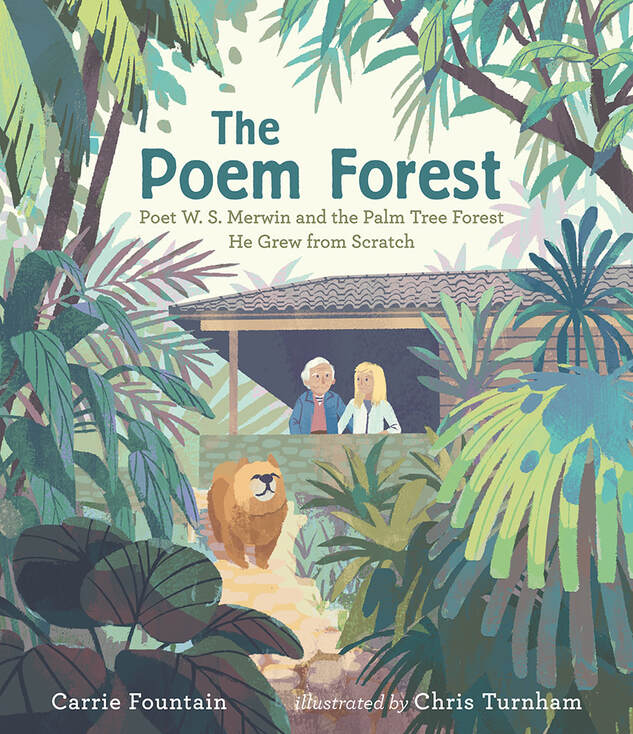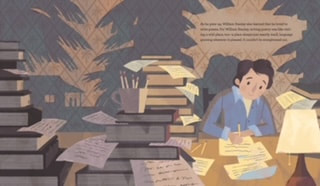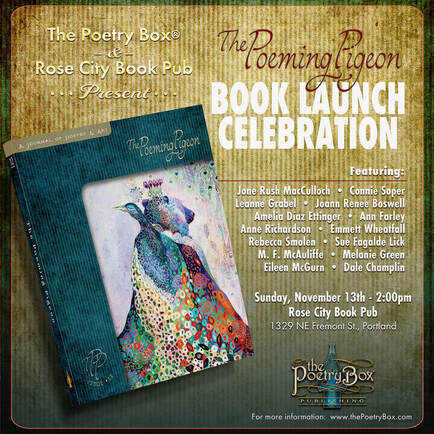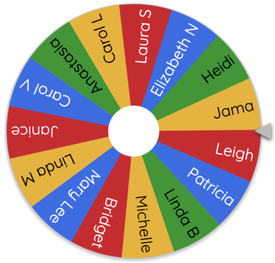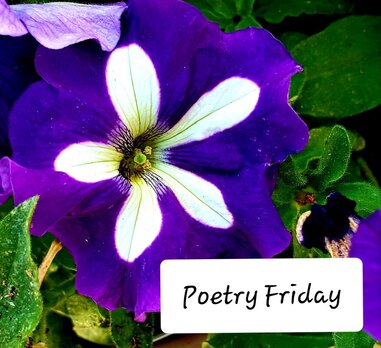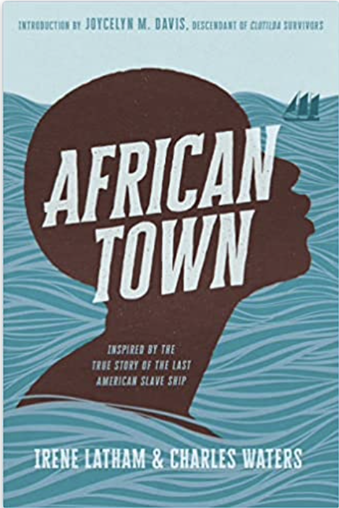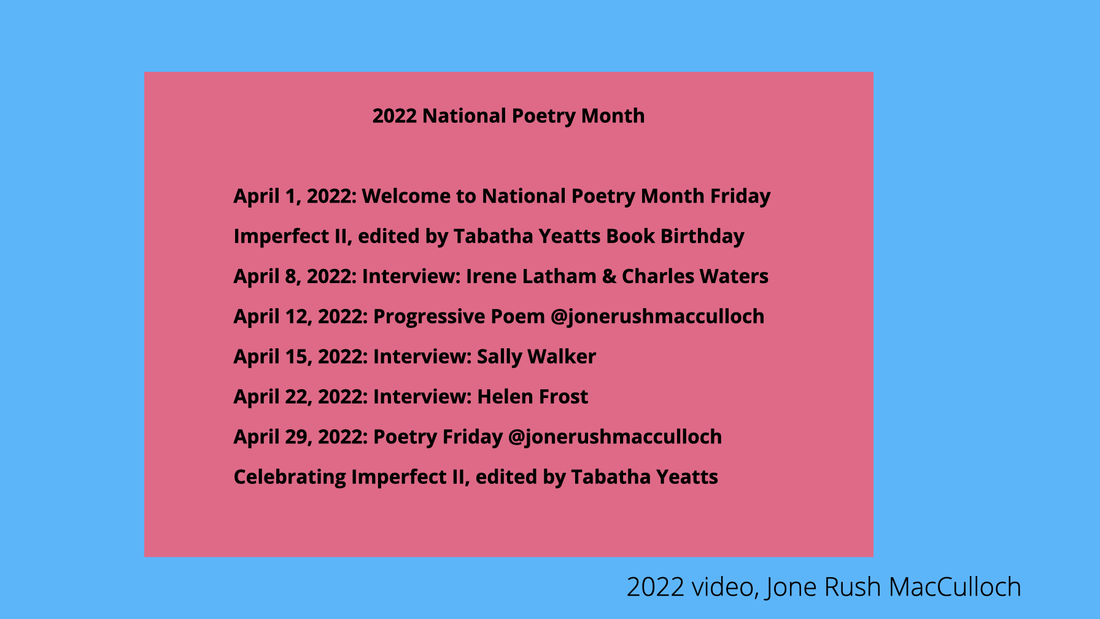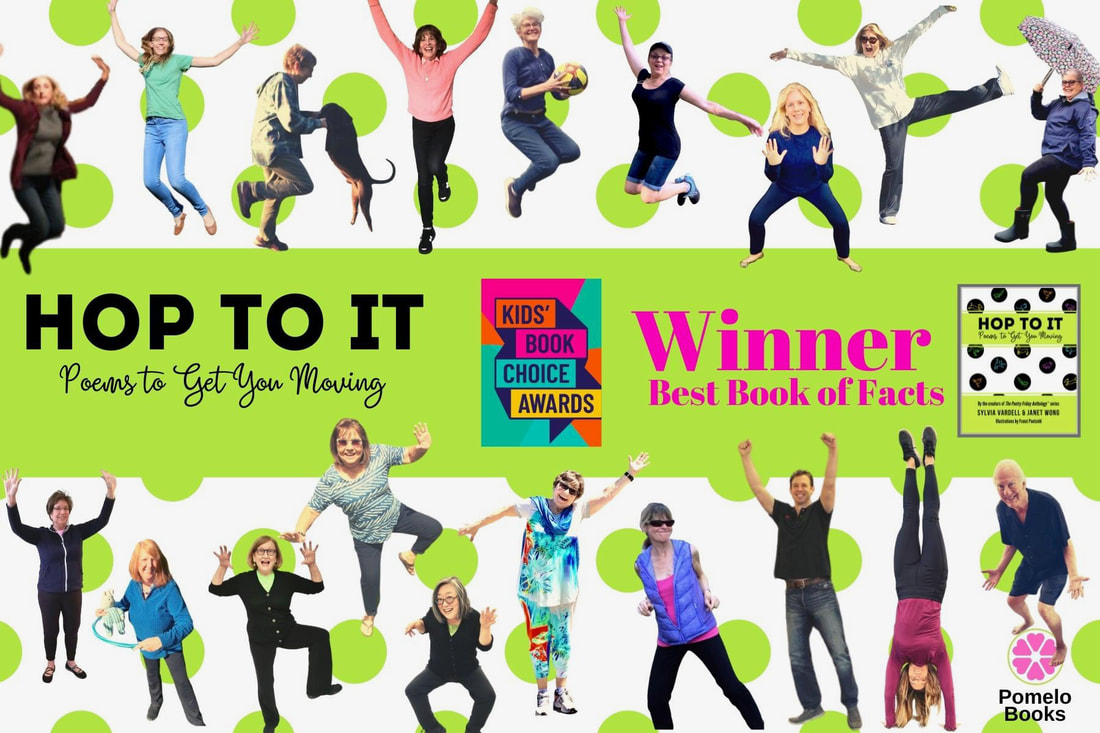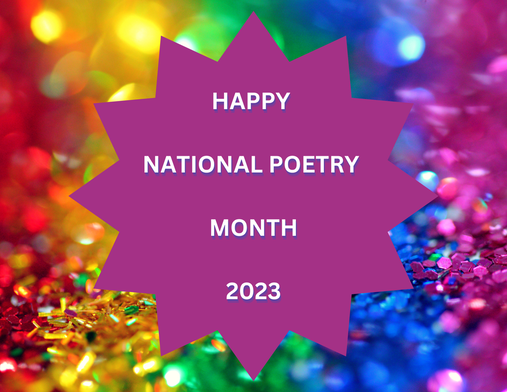 Thanks to Ruth at There is no such thing as a God-forsaken town for hosting today, the last Friday of National Poetry Month. Between the awesome poem videos from the students of Texas Women's University, The Classic Found Poetry Palooza, and the author interviews, it has been a fabulous month of poetry. Today I having Sally Walker returning with her new book, Trees: Haiku from Roots to Leaves. I was thrilled when Anne Irza-Leggat, Candlewick Press, presented me with the opportunity to interview Sally Walker again with her latest book. 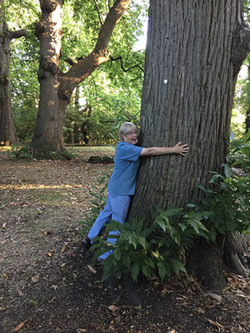 This picture! Yes, I used it last year and it speaks volumes about Sally's love of trees. JRM: At your website, you have a photo of you hugging a tree. And in your author’s note, you mention how you and your sister loved trees. Can you share more about that experience, your love of trees? SW: We were fortunate to have many excellent, memorable trees in our neighborhood. My father planted a Norway maple tree on our front lawn shortly after he and my mother purchased the house I grew up in. By the time I was 10 years old, it was perfect as “home base” for many of the games we played with our friends. The oldest tree in our city—a swamp white oak—was two houses down from my mine. There was a brass plaque set into a concrete slab beneath the tree that informed passersby of this distinction. Based on the city arborist’s calculations regarding the tree’s age, we estimated that it had started growing about the time when George Washington was a young man. A long block away from my home, two copper beech trees towered above the very large lawn of an insurance company. Their hefty, almost two-foot diameter trunks supported numerous widespread, thick branches, some of which nearly touched the ground. Perfect climbing trees that became pirate ship riggings or Sherwood Forest hideouts, depending on what we decided that day’s adventures would be. And today, 55 years later, in my mind I still vividly hear the whistles of the cardinals and the raucous screeches of the blue jays that raised families in the pin oak trees outside my bedroom window. JRM: You have another tree book, Champion, The Comeback Tale of the American Chestnut Tree. What led you to write another book on trees? Did the idea percolate when researching Champion? SW: The idea for TREES was not percolating at all when I was researching and writing CHAMPION. As a matter of fact, I had scarcely begun writing EARTH VERSE, my first haiku book, at the time. I’m not sure exactly what led me to writing TREES. In looking back over my first drafts, I see that the earliest one dates to the month when we had to have an aged silver maple in our front yard cut down. We replaced it with a lovely Autumn Blaze maple. I remembering thinking that I was going to miss the old tree and wondering what the new one would look like in the fall. From there, I suspect that the idea for TREES made its way into my thoughts. Also, the folks I work with at Candlewick—my editor Hilary Van Dusen and copyeditor Hannah Mahoney (who is an amazing haiku poet)—put the “dream” in “dream team.” I really wanted to continue working with them. Hilary likes trees, too, so the topic seemed another good haiku fit. JRM: What was the most “tree-mendous” discovery you had in writing this book? SW: I love puns! Thanks for that one, Jone. The tree-mendous discovery for me definitely was learning how trees communicate with one another. I’ve always imagined that the sound of leaves shushing in the wind was the trees whispering amongst themselves. It is one of my favorite sounds. But learning that trees send air-borne scent signals to one another and also communicate nutritional-need signals via their root systems—well, that’s pretty mind-blowing stuff! Now when I walk in a forest, I am aware that a network, almost a magical one, surrounds me. And it makes me wonder how certain trees might be relating to those that surround it. JRM: Would you share a little about what a writing day looks like to you from research to sitting and writing and in-between? Would you have an early draft of a poem and the finished poem? SW: First off, especially when I’m writing haiku, I always, always have my copy of Roget’s Thesaurus on my desk. My parents gave the book to my husband as a gift when he graduated from college. Although it was originally his, during the 49 years we’ve been married, it’s slowly become mine. Its red, cloth cover is heavily worn on the edges and there are a few tears as well. But I would NEVER replace it with a shiny, new “model.” A lot of my haiku are written while I am walking outside. After all, immersing oneself in nature is kind of what haiku’s all about. It’s often where the germ of a haiku begins. I mostly write using a computer because typing is easier on my fingers than writing with a pen. But I have my desk positioned such that I have a window on each side of the desktop. When I pause to think while I am writing, I can see our Autumn Blaze Maple if I look to my left. (And it is a gorgeous, flaming red in the fall.) If I look out the other window, to my right, I can see the thin stems of one of our four serviceberry trees. In April they get silvery blossoms that give rise to purple berries in late June. They taste similar to small, sweet blueberries and make yummy pies. Oops. I am supposed to be writing about my writing day, not trees. Sigh. JRM: That’s quite alright, I would do the same. SW: I write best in the morning. If the writing and idea flow is going well, I can spend hours at the computer without taking a long break. Time flies then. However, sometimes I hit a technical (usually scientific) stumbling block and need a research break to resolve it. Then I’ll head out to either the public library or the university library in town to seek the answer. Libraries are among my favorite places. Traditionally, haiku are three-line poems with a 5-7-5 syllabic structure. Today, many haiku writers choose not to follow that pattern and instead use a differing number of syllables to convey the sense and imagery of their poem. I love playing with words, so I enjoy the challenge of finding just the right word and just the right phrasing while sticking to the traditional structure. It’s a game, a puzzle, and for me that’s fun. Sometimes when I’m writing I take short breaks to play with my cats, who can be very persistent when they want to play. Sometimes I work in the garden. As evening approaches, I cook dinner. But even when I’m away from my desk, haiku thoughts and words simmer in the back of my mind. Every haiku has more than one draft. There’s the “get something down on paper” draft. Followed by the “there are too many syllables in these lines and the words are not precisely what I want” drafts. (There are at least several of these drafts.) And then, often days later, the “Eureka! How could I NOT have thought of this word or phrase before?” draft pops into my mind—often while I’m out walking! There are usually two “eureka” drafts. The first draft is almost, but not quite, there; the second nails it. JRM: Were there poems that didn’t make the cut for this book? SW: Yep. Several. One of them we cut was one of my favorites: musical murmurs the spring peepers’ sweet chorus wakens the forest Spring peepers are another of my favorite sounds. I think due to space/pagination considerations we had to drop a few haiku. I really hated having to eliminate this one. But we had another springtime haiku: covered with gray fur pussywillow catkins cling: kittens on slim twigs that I love equally and thought children would too. Who doesn’t like holding a pussywillow? I chose to keep this one because I thought my cats would get angry at me if I cut it out. JRM: What is next for you? Projects? Adventures? SW: I am very excited about—and had LOTS of fun writing—two board books that will be published by MIT Kids Press in the fall of 2024. The rhyming text invites kids to “chime in” on repetitive refrains. And the dynamic illustrations will provide plenty of discussion opportunities between parents and young listeners/readers. As to adventures…who knows? I’m always open and on the lookout for a new adventure! JRM: Here's to new adventures, more trees, and being outside. Thank you, Sally. Remember, I will be announcing four winners to receive a copy of one of the four books. And watch on Saturday for the final poem video by my TWU students. It will make you smile, especially if you have chickens.
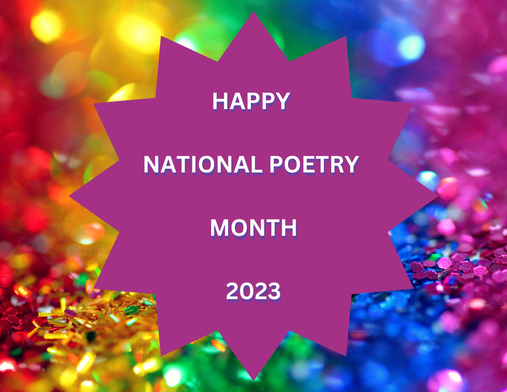 Karen at Karen Edmisten* has hosting duties today. She's featuring a fabulous poem by Ted Kooser. Today I am interviewing Charles R. Smith, author of Soccer Queens which is a terrific book like his previous Hoop Kings and Hoop Queens series. Thanks to Anne Irza-Leggat, Candlewick Press, you have an opportunity to win one of the four books by the four authors I have interviewed this month. You have all month to comment on the interviews. At the month's end I will select four names for the four books. 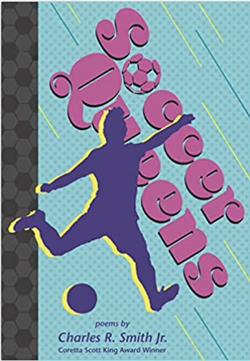 JRM: Did you have an idea for this book or did it evolve as you watched all the hours of soccer play, learned the positions, and the rules? CRS: The idea for Soccer Queens actually came from my editor since she's a big soccer fan. I had previously done Hoop Kings 1 and 2 and Hoop Queens 1 and 2 so I thought it would be a great addition to what is now a series. JRM: In the Poem Notes, you mention being drawn to the Women’s Soccer team in 2019 as they defended their World Cup crown. What was the process you used to figure out which women to include in this book as well as the arc of the book? CRS: In watching the 2019 World Cup I got to see the sport played at it's highest level and the atmosphere that created. Certain players stood out because of their position so they were easy to include, like Alex Morgan. But for the book, I had to make sure I had every position represented so as I looked for the top players at each position, I got to learn more about the game, which helped me to write about it. As for the arc, my editor wanted to include the '99ers since they inspired many of today's best so I wanted to give them a fitting tribute to show how they planted the seed for what the sport is today. JRM: Were there players you researched and wrote about that didn’t make the book? CRS:At the beginning of any of these Sports Royalty projects I first focus on who will be on the "roster". Because if they make the roster, they make the book. JRM: Would you consider another book for them? CRS: Most certainly! Not only because the others now have a volume 2, but because by the time the book comes out, there are already new players making a name for themselves. JRM: Would you have an early draft of a poem and then the final draft so readers can take a peek at the process? CRS: I thought I had SOMETHING around but sadly I do not since most of it was written on paper that likely got tossed after being transferred to the computer. JRM: I noticed you started in photography transitioning into writing. Can you share about that process, were you always a writer? As a photography hobbyist, I’m curious about how you got started in photography. CRS: I was a writer long before I was a photographer. I got introduced to photography when I joined my high school yearbook staff in 11th grade. I signed up to be a copywriter, but since our staff was small, everyone did everything. The photographer who did our school portraits gave us a photo bootcamp and I was actually the worst one when our pictures came out! But I was also the only one who was really looking through the viewfinder. I got up in a tree and shot down. I laid on my belly and shot up. I was the only one doing that because I really enjoyed pointing a frame around how I saw the world. The fact that my photos weren't exposed properly only added to my excitement to learn and get better at. As I improved I then determined that I would move, go to photography school at Brooks Institute in Santa Barbara, California after I graduated high school and then move to NY to eventually work as a pro. And two days after I graduated, that's what I did. I got back into writing when I was photographing the burgeoning spoken word poetry scene in NYC. I connected with the poets as their performances inspired me to start writing again. With their encouragement, I got better and continued writing. I was able to merge the two when a series of basketball photographs would become my first book, Rimshots, which I also wrote. JRM: This term I have been working with future school and public librarians about bringing poetry into the library. We have been discussing the power of performing poetry. You perform many of your poems. How and why did you decide to create videos? CRS: The type of poetry and writing I enjoy, begs to be heard out loud. Having photographed some of the best spoken word poets let me see how poetry can be brought to life. The fact is, many people don't enjoy poetry because they treat poems as museum art. They know it's something special but they don't get it or understand it. They make it bigger than it needs to be. There are poems out there for everybody so if someone doesn't "get it" or like it, they don't have to feel obligated to understand it, they can just look for something else. Many of the poems that do catch our ear, take on a life of their own when read out loud or performed and can add a whole different level of enjoyment. As for the videos, my goal is to show the power of performing poetry, and to provide some assistance on the instruction and appreciation of poetry. JRM: What additional suggestions about performing poetry? CRS: I always recommend to anyone reading poetry, to read it out loud. Since wordplay is a tool of the poet it can get lost when words aren't actually spoken, but just read. I also tell budding poets to read what you wrote out loud to yourself. This helps define your line breaks and helps you find a natural rhyme pattern and rhythm. JRM: What is your next project? CRS: My next big project I'm working on is top secret lol but I have plenty more books coming out over the next few years starting with a biography in verse on the Black bicycle racer, Major Taylor. I will also have Hoop Queens 2, Black Diamond Kings (for Negro League baseball), and World Soccer Kings all coming out over the next few years to add to the Sports Royalty series. I also have a picture book on Mae Jemison that focuses on how she fell in love with space. And somewhere in the midst of all that will be the top secret project...so I better run to get working on that. JRM: Thank you so much for this interview, especially answering questions about performance poetry. Listen to Charles R. Smith, Jr. read his work. Soccer Queens Alex Morgan: "Automatic: Soccer Queens Megan Rapinoe: "Rocket" Shout out to the Texas Women's University students who have been gracing my blog all month. I hope you have had a chance to watch some.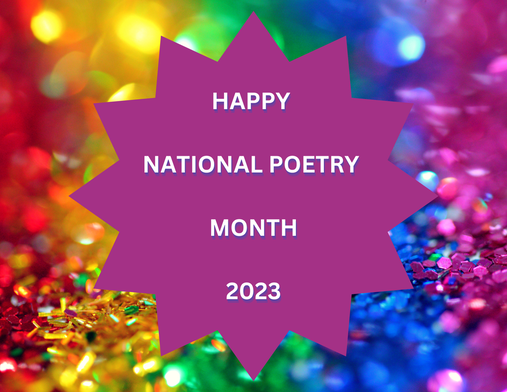 Margaret at Reflections on the Teche I am once again working with Anne Irza-Leggat, Candlewick Press to bring four interviews for Poetry Friday. Anne has graciously offered to send a book to a lucky commenter. You have all month to comment on the interviews. At the month's end I will select four names for the four books. 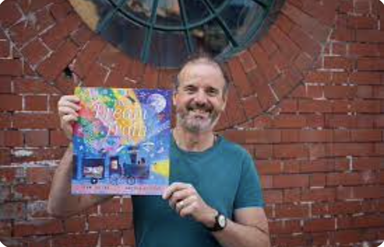 Sean Taylor, author of The Dream Train Sean Taylor, author of The Dream Train JRM: I really enjoyed The Dream Train. The poems were a great combination of having fun just before bed and then settling into dreamland. I didn't ask a question about the moon poems but they are among my favorites. How did you come up with the idea for The Dream Train? ST: I’ve been writing poetry since my teens. The first times I read out writing to audiences were as a performance poet in the 1990’s. The first book I published (back in 1992) was a collection of poems for adults. The first writing I ever did for children was poetry. And I put together a collection of my poems for children 30 years ago. It was a mish-mash of poems, with many styles and themes, entitled SNAKES AND LADDERS. That came close to being published. But an editor had a change of heart, and the book never happened. Then I drifted away from poetry a bit. I started writing picture book stories and publishing quite a few. So stories for children became my focus for quite a few years. But I showed my mish-mash collection of poems to an editor I was working with. She had a read and wisely said that I should try coming up with a more focussed book of poems with one specific theme. I liked that. And, drawing off my experience of writing stories for bedtime, I decided to have a go at putting together a book of poems about night-time, sleep and dreams. The vision was a picture book of bedtime poems. And that became THE DREAM TRAIN. JRM: I have always had wild dreams (like just this week one about being in lock down because a cougar was roaming the school yard) so I especially loved “Run Free”. Was that poem or any of the poems the result of a dream? ST: No. None of the poems was sparked directly by a dream. Though dreams have given me stories and poems in the past. I wrote this once. It has an adult feel, and wouldn’t have made it into THE DREAM TRAIN! THE MAN OUTSIDE I dreamt a man with a hammer was outside. He was trying to break into the house where I grew up. I couldn’t see him. He was in the darkness beyond the blue-framed windows. I was indoors. And I was ready to do anything to keep him out of my family’s home. But I knew that the man outside, with the hammer, was me as well. And I do love to turn over pieces of writing in my head in the semi-dreaming, twilit mind-space that comes shortly before falling asleep. A lot can happen then. I’ll scribble thoughts and images in a bedside notebook, or find they comes back to me when sitting down to write in the morning. That was part of my process as THE DREAM TRAIN evolved. JRM: There is a lot of fun word play in this book such as “Rain, Rain, Rain” and “The World is Busy.” Do you keep an interesting words list? (I’m always writing down words). ST: Well guessed. Yes! I do have some strange and beautiful word collections that I’ve gathered over the years. Sometimes I look/think them through, when writing. Among these are … NAMES (handy when writing stories), GROWN-UP THINGS THAT CHILDREN LIKE SAYING, TONGUE TWISTERS, and EXPLETIVES THAT YOU CAN USE IN WRITING FOR THE YOUNG. (The latter includes Dog my cats! Geewhillikins! and Oh jiminy bliminy criminy!) JRM: I love how the poems in this book go back and forth with playful, animals and tenderness such as “The Blanket” and “Grandpa’s Guitar” Were those experiences you had as a child? ST: No. Neither THE BLANKET nor GRANDPA’S GUITAR is based on a personal experience I had. But I’ve known musical grandfathers. And I’ve known knitting grandmothers. Characters and images arrive, like guests, when writing poetry. And when you feel there’s truth in them, they’re warmly welcome to stay. JRM: What was the process in deciding the arc of the book and the sections? ST: That was down to good editorial thinking. The book was edited at Candlewick’s UK arm - Walker Books. I’m lucky to work with Maria Tunney and Tanya Rosie there (a very smart duo of editors.) I sent them my manuscript for THE DREAM TRAIN, with the poems ordered in no particular sequence. I’d just put them side by side in a way that I thought chimed. But Maria and Tanya came up with the idea of splitting the book into sections – one with a theme of heading for bed, one with a theme of being in bed and going to sleep, and one with a theme of sleeping in the middle of the night. This led to the three (equal) sections of the book: NIGHT ARRIVES, SHUT-YOUR-EYES TIME and DREAM WHEELS TURNING. And I think they work. JRM: Were there poems that didn’t quite make the cut for the book? ST: Yes. Five or six, perhaps. There was one about a river flowing on through the night: Lights go out. Darkness grows. But all night long, the river flows… Something along those lines. I quite liked that one! But my editors suggested cutting it - and you give and take, when making a book. There was another rather long poem called Its BEDTIME IN MONSTERLAND. And I suggested cutting that myself. You write long, then distil down. And – to extend the distilling metaphor - I find that books get better the more you take out. 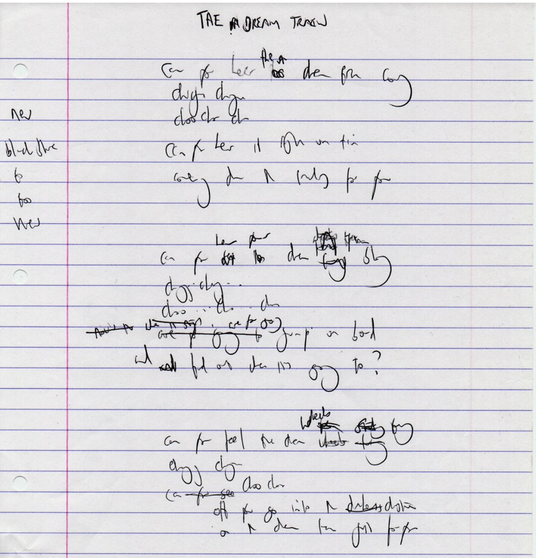 JRM: Would you have an early draft of a poem and then the final draft so readers can take a peek at the process? ST: Sure. Here are the first scrawling scribbles of the poem that gave the book its title. (See how I’m trying out a little collection of rhyming words in the lefthand margin.) 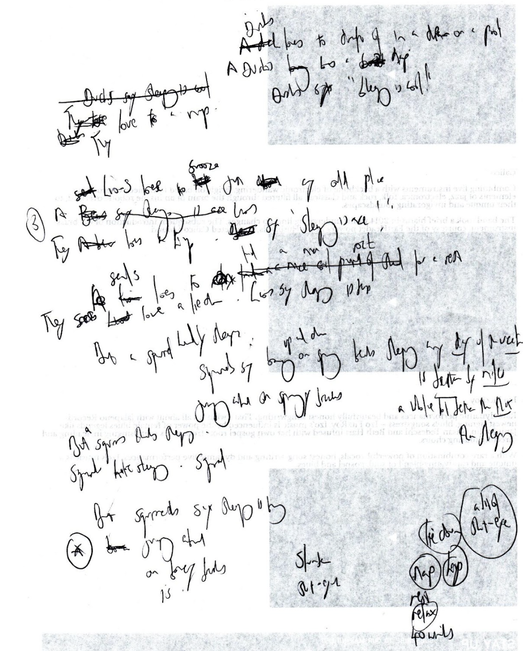 ST: Here’s how I wrote the poem DUCKS LOVE TO DREAM. (At the bottom on the right, I’m thinking up alternative words for sleep. I suppose that’s what I do. I dream-up the possibilities. Then I settle on the ones that work best.) 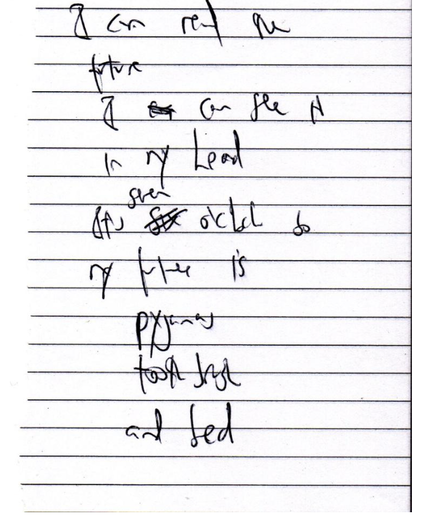 ST: And this one came out just about ready, first time. JRM: What is your next project? ST: I’m delighted to say that THE DREAM TRAIN is the first in a trilogy of poetry books for under-8’s coming out from Walker Books in the UK (and, I hope, Candlewick Press in the US.) YOU’RE A POET is due to be published in the spring of 2024. It’s a story-based book, for the very young, about poetry – with each story leading to a poem-writing challenge. Then FIVE LITTLE FRIENDS will follow in 2025. That’s a book of finger rhymes that I’ve come up with. I love using finger rhymes when doing poetry performances for small children. The combination of lyrical language and expressive finger movements has a wonderful, naturally interactive effect. Young children step right into the poems both physically and imaginatively. So it’s a life-filled form to work (and play) with. JRM: What wonderful news about The Dream Train being the first of a trilogy. Congratulations. Coming UP: I'm hosting Poetry Friday next week. Get ready for Classic Found Poem Palooza! 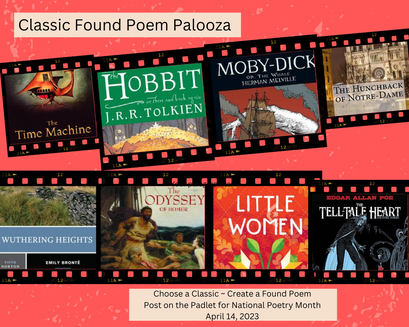 On Friday, April 14. I am hosting Poetry Friday and the Classic Found Poem Palooza. Here's the Padlet link to upload your poem. I have put a permission to upload on it as I want to protect the space. Finally, please drop by and drop a comment on the great poetry videos produced by my TWU students. They are posted daily. I am putting together a poetry prize for those who show love to these projects. I will draw a name at the end of the month. 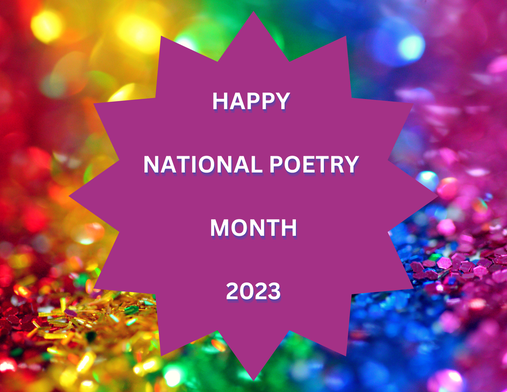 It the Eve of National Poetry Month! Mary Lee at A(nother) Year of Reading is hosting and sharing what her month of poetry will be: Cheritas! I am once again working with Anne Irza-Leggat, Candlewick Press to bring four interviews for Poetry Friday. Anne has graciously offered to send a book to a lucky commenter. Today I have a wonderful interview with Elizabeth Bicknell, longtime editor for Paul B, Janczko. His final collection, Where I Live, was published on March 14, 2023. It explores a the places and spaces of where we live. 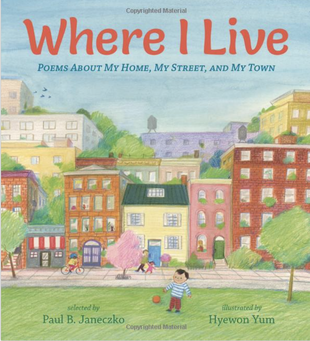 JRM:How long were you Paul B Janeczko’s editor? LB:I started working with Paul back in 1996, when I was still at Harcourt Brace. When I moved to Candlewick Press in 1997, I brought him with me, and we published the anthologyVery Best (Almost) Friends, illustrated by Christine Davenier. Lovely to have started with a collection of poems about friends, since that is what we became over twenty-plus years, till his passing in 2019. JRM: Did you work with him on Requiem: Poems of the Terezin Ghetto? LB: I edited nine of Paul’s books. Seven of them were anthologies, including two of my favorites--A Poke in the I and A Kick in the Head, both illustrated by Chris Raschka--and two were his own, longer collections of poems, such as Requiem. The other one is Worlds Afire, poems about a circus fire in Hartford, CT, 1944. Both of these collections (Paul refused to refer to them as verse novels) are powerful meditations on terrible events, focusing on individual experience. He made history vivid in that way. PBJ, as we called him in-house, was an excellent poet, teacher, and appreciator of poetry. I learned so much from him. JRM: I’m curious. What are one or two things Paul taught you? LB: Paul taught me a lot about the various poetic forms. I knew the basics, like the haiku and the sonnet, but I didn’t really know the more complex forms—sestinas, villanelles, aubades! He also taught me that these rules—just like those of his beloved baseball—are actually exciting to know and enhance your experience of the “game.” JRM: How did he come up with the idea for Where I Live? LB: Paul had anthology ideas bubbling away all the time. He kept paper folders of printed poems, and when there seemed to be a collection forming, he’d email me and say, “Hey, Ducky, how about this idea?” I turned down some of them, which went on to be happily published elsewhere, of course. JRM: Janeczko passed away in 2019, I am curious as to where in the process of creating the book? Were all the poems selected? LB: Yes, nearly all of the poems were there. In winter 2019, we had just finished The Proper Way to Meet a Hedgehog--Paul saw the bound book a couple of weeks before he passed. After a little while, we put ourselves back together at Candlewick and opened the file on Where I Live. We added some poems, and then we began the search for an illustrator. JRM: What is the story about how this book will go into the world four years after Janeczko’s passing? LB: For me, personally, it feels very fitting that Paul’s last anthology should be about home. JRM: What kind of insight can you provide about how a poem gets selected for a collection? LB: There are so many aspects to this process. First and foremost, the anthologist selects poems that they love and which fit the theme they have chosen for the book. For most young anthologies, you’d want about 30 to 35 poems. As an editor, I look to ensure that the anthologist has selected a good variety of new poems as well as previously published poems; included a diverse collection of poets; featured a variety of poetic forms; considered age-appropriateness for content and comprehension; and, finally, understands the likelihood of obtaining permissions at a reasonable cost for inclusion. JRM: Could you share a little bit about the process for getting permissions? LB: Every poem—apart from those that are in the public domain and therefore free to use—needs a permission from the rights holder before it can be included in an anthology. The rights holder could be the poet, the poet’s estate, the poet’s agent, or a previous publisher of that poem. The anthologist’s job is to track down who owns the rights to the poem. Then, the anthologist will give the rights holder the details of the book where the poem will appear. The rights holder will want to know whether the book is hardcover, softcover, e-book, or all three, and where it will be published. They will probably ask for the retail price and the print run. Then they will ask for a fee, based on that matrix of information. JRM: Readers are always interested in the arc of a poetry book. My guess is that the sections go from the innermost circle of “Home” to the larger circle of “Town/” What does that look like to decide the arc and order of a book? LB: This is definitely a fun part of the process! In Firefly July, we divided the poems into seasons. In Where I Live, we decided to expand the horizon from the home to the neighborhood and beyond, as you surmised. Since we wanted to include urban, suburban, and rural neighborhoods, there was a fair amount of futzing, i.e. moving poems in and out of sections till we were satisfied that Paul would have been happy with the collection. Then my colleague Carter Hasegawa cleared the permissions on Paul’s behalf. JRM: What is your favorite memory of Paul B Janeczko? LB: I have so many, but hearing him rave (or rant) about his beloved Red Sox was always fun! Classic Found Poem Palooza Almost Here! On Friday, April 14. I am hosting Poetry Friday and the Classic Found Poem Palooza. Here's the Padlet link to upload your poem. I have put a permission to upload on it as I want to protect the space. 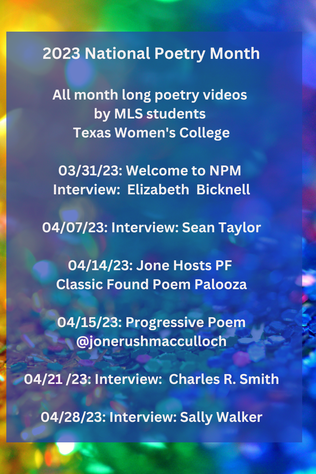 Come back tomorrow and enjoy the first of the month long poetry videos created by the students of the Texas Women's College, Poetry for Children and Young Adults! 'They are fun, thoughtful and will be perfect for a poetry break. Thanks to Sylvia Vardell for pointing me toward this opportunity. Also a huge thanks to the poets who donated a poem to the project. 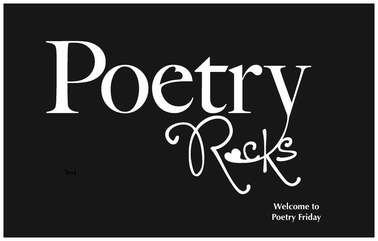 Graphic Design by Amber Fleek Graphic Design by Amber Fleek
Jama at Jama's Alphabet Soup has Poetry Friday hosting duties today. She's cooking up a delicious Thanksgiving parody poem. Plus she always has the most scrumptious food photos.
Today I have an interview with Rebecca Brock, author of an adult collection of poetry, Each Bearing Out. I "met" Rebecca in Laura Shovan's February Poetry Group on Facebook. She just published this wonderful collection about motherhood and the natural world. 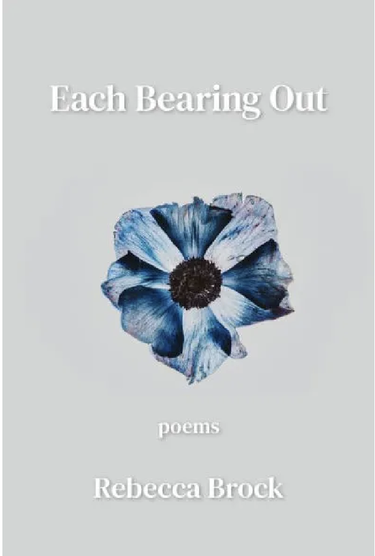
JRM: What was the process that led you to create Each Bearing out? Did you set out to write a
collection or did you write poems and then one day realized that there was a collection? I noticed that several poems found homes in journals first. RB:Thank you, Jone, for reaching out to me and sending me these questions. So much of this journey for me has been one of permission. I was finally writing again, after a long silence, and it took me a while to acknowledge to myself that I was writing poetry. I hadn’t written poetry since my undergraduate years—I studied fiction in graduate school and had only ever published in nonfiction. But I was writing a lot of poems I referenced as my “mom poems.” They felt very personal, like small snapshots caught from the blur. Eventually, I had so many that I began to think about making a small book. JRM: Have you always been interested in the natural world? I noticed you are originally from Idaho. How did growing up in Idaho play a part in your writing life? RB: I grew up in Boise, Idaho but moved away over twenty years ago. I’d always planned to go back, but life gets complicated and that distance between my original home and my home now informs a lot of my writing. I think my interest in the natural world has grown deeper through my experience of mothering. My kids were curious, input seeking creatures and seeing the world through their eyes is what’s really brought me back to noticing, and paying attention to the natural world. JRM: I was really struck by the poem “Good Housekeeping”. I struggle with keeping house, writing and being engaged with my family. Add the concerns about the environment, it really gets overwhelming. What is one event that led you to write that poem? RB: “Good Housekeeping” resonated with a lot of my friends who have been busy mothering through these last years. It was originally published with the tag line “America during Covid, during Trump.” There has been such a constant tumult these last several years—political, social, environmental. I would be trying to do the most ordinary thing like decorate for Halloween or vacuum and just feel this redundant dread, as if I were participating in a great pretending that lets us go on believing everything is fine. The question, for me, is still a constant—how do we mother these children toward a future we can’t even begin to fathom? JRM: Could you share with readers your process with how you decided the order of the poems? RB: Mostly instinct. I read them out loud, a lot, and paid particular attention to what would be the first and last poem. I printed them out and sorted them physically, by hand, all down the hallway in my basement. From there, I semi-sorted them chronologically according to my children’s ages in the poems, which left me with a burgeoning teenager by the book’s end. JRM: Were there poems that didn’t make the book? How did you decide which poems were in and which needed to be held for a different space? Are you planning a second book? RB: Yes! So many didn’t make it. Poems I felt were weaker or redundant…or too sentimental. I have so many poems about my kids, it is really how I’ve found a way to hold my own memory of these years. I also asked two friends, Liona Burnham and Ruth Lehrer, to read through a near-to-final draft and tell me their suggestions. It was easier to know what to leave out than what to leave in! I am working on my second book already—about landscape and distance, origin and loss. JRM: How did Laura Shovan’s February Poetry Month inspire you? RB: Laura Shovan’s February Poetry Month arrived in my life at just exactly the right time and inspired me entirely to keep writing and to trust in my own voice and the power of showing up to the page. I had been working in such solitude and suddenly I was in the (online) company of bright, gutsy, gracious poets willing to post such new writing every day—it made writing poetry both more magical and more ordinary. Again, I think I was seeking permission and the poets from February Poetry Month absolutely holler their permission at you every day you post. It’s quite a gift and I’m so grateful, every year I participate, for Laura and for the generosity of that space. JRM: How did “A Rock is a Rock is a Rock” come to be written? It made me feel the pain and sorrow when your child comes home from a bad day at school, juggling schedules, dinner, and empathy. RB: It’s an entirely true story and it’s about my boy who is all heart with arms and legs attached. He is constant and somedays I just can’t keep up. But he is also the kind of person who places you, in moments, in the absolute of now. Here's "Rock is a Rock is a Rock" Originally appeared online at Whale Road Review, Summer 2022 A Rock Is a Rock Is a Rock You got your feelings hurt at school, again, you tell me seriously that you feel a heartbeat thump thump thunking in your pet rock, you swear you can. I say it’s your own heartbeat, in your palm, hammering. I am straddling dinner and your brother’s baseball game-- and you try to explain how your best friend tried to make you throw the stupid thing away. I say I told you not to take it to school, I told you, over and over, a rock is a rock is a rock. I almost say, out loud, baby sometimes you’re just too much but your breaths are coming hard, your small chest heaves—love, there is nothing weak about you. I turn the stove off. You let me hug you, the pulse of you barely surface deep. When you let me hold him, Rocky is still warm. You believe in so many things, even me. JRM: What can you share with readers who are exploring writing chapbooks? RB: Calling it a chapbook necessarily focuses your theme and scope—and that helped me get my mind around the idea. I wasn’t trying to write a book…I was only working on a chapbook. I read a lot of other people’s chapbooks. And I looked up contest deadlines and used them as goalpost deadlines. I found poets whose work I admired, in literary journals I like, and I ordered their books, scoured their bios for ideas of where to submit. Submitting my poems before they were part of a book also provided me a sort of scaffolding—I knew certain poems had resonance and strength. Time to Think About 2023 New Year Postcard Exchange
Won't you join us? Sign up for the 2023 New Year Postcard Exchange. Send five, send ten or send to all. Did you know there are 44 days until 2022 ends? Woohoo! Let's celebrate the New Year with a New Year Postcard? In Japan, it’s called Nengajo, a Japanese custom of ushering in the new year.How It Works:
One More Announcement!
I have very exciting news.
It started as a disappointment, my in-person poetry reading for November 13 was canceled due to health concerns of one of the editors. However, they have decided to go with a Zoom Reading for Issue 12 of The Poeming Pigeon on Saturday, December 10 at 4:00 PST. I will be sending out the information as soon as I get a hold of it. I’m excited because now my online poetry friends will be able to tune in. 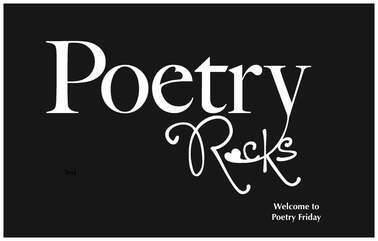 Today, Heidi at my juicy little universe is hosting Poetry Friday. Heidi has a n important PSA about voting, Plus a whimsical challenge for us. Did you know that Nov 14-20, 2022 is Folk Tale Week. Read about it at my juicy little universe. There are some wonderful prompts. Last Spring, I connected with Anne Irza-Leggat from Candlewick about interviewing poets. Carrie Fountain is the final of the four poets I interviewed. The Poem Forest is her first book for children but it's not her last one. 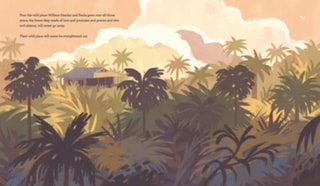 JRM: What drew you to the idea of writing about W. S. Merwin’s love of trees and ecology? CF: As a poet myself, I came to know W.S. Merwin first through his writing. When I came to learn of his moving to Maui and planting trees, it just struck me as a perfect story for kids. Merwin made his environmental activism a part of his everyday life. I think it can sometimes feel very overwhelming for kids (and adults!) to contemplate their actions against the large, swirling problem of, say, climate change. And I think Merwin's story offers inspiration: small, everyday commitments can make a difference. This is convenient, as our small, everyday lives are all that we have to work with. JRM: What was your process for writing this book? CF: Really, my desire for this story was to make a connection between Merwin's writing practice and his planting practice. A lifetime commitment to writing means a commitment to sitting down to do it everyday. I think some people imagine poets as people who walk around waiting for inspiration to strike and then jotting down whatever comes to them, and boom: a poem comes to you whole and finished. But that's not how it works! You can't plant a forest all at once. Like writing, it's something you attend to daily. I started writing this book with that idea in mind, and then read everything Merwin wrote about how he found his piece of land, how it was in very bad shape, and how over many years he went out daily to plant palm trees. There was something so meaningful to me in that commitment. And I thought it'd be meaningful to kids, too. JRM: I think one of the best parts about writing is doing research for a topic. What kind of research did you do for The Poem Forest? CF: Merwin wrote (very beautifully) about how he came to make the palm forest, and read everything I could find. Then I read his memoir Summer Doorways and learned more about his early life, and his longing to be in wild places, and his concerns about the environment and his deep sense of place. Rereading his poetry with the wider knowledge of his life, I was able to see how the line between the palms and the poems slowly begins to thin. There is so much meaning and metaphor taken from his experience in planting and living among the palms. JRM: What was the most surprising discovery you had in writing this book? CF: When Merwin first found the plot of land on which he'd plant his forest, it had been a failed pineapple plantation. I knew the basic story--the soil had been misused and needed repair. But I was surprised to learn just how much faith he'd had in that particular spot. People tried to talk him out of buying it. In the record books there was a note about the parcel that read "Nothing will grow here." Merwin wasn't a rich man with money to burn. So the fact that he allowed the land to speak to him, and that he took that chance and made that commitment was doubly inspiring to me. It makes one reflect on choices one has made in one's own life, and how it's best to truly look for room for challenge and faith and promise, rather than playing it safe. JRM: What is one of your favorite W. S. Merwin poems? CF: There are so many. I included his poem "Palm" at the end of the book--and I love that poem. He wrote many poems about the forest and about the palms. But I think my favorite W.S. Merwin poem is called "Thanks." It's a poem about our human pull toward offering gratitude, even in the face of great problems beyond our control. It ends: with nobody listening we are saying thank you thank you we are saying and waving dark though it is JRM: This is your first children’s book. What differences( if any )did you find writing for a target audience of children versus adults? CF: I think a lot of that is instinct, and remembering how smart and funny kids are. There are differences between these two audiences, but when you start focusing on the differences--what you can and can't say--you get into trouble. I like to imagine my own kids as my readers, and knowing how deep and philosophical they can be, I feel very comfortable going places that might feel very "adult" to others. So often I find children have much better access to the big, hairy, existential questions of life. JRM: Will there be more books for children in the future? What are your upcoming projects? CF: YES! I'm currently working on a book about work. I've always been fascinated by the idea of what people do all day. This book is a playful investigation of what work means, and what people actually do at their jobs. I want to celebrate the dignity of work and showcase jobs that don't always get attention in children's books. I think a lot of kids have trouble finding their own parents' jobs represented in books--and so I thought I'd write a book for them. Thank you, Carrie, for this great interview. I loved The Poem Forest so much. I am looking forward to your new book. If you would like to win a copy of The Poem Forest, leave a comment. a winner will be selected next week. Thanks to Anne Irza-Leggat from Candlewick for offering a copy to someone. 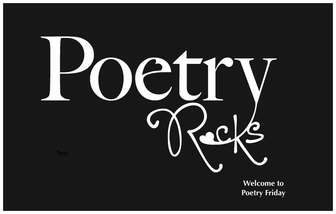 The fabulous Tabatha at The Opposite of Indifference is hosting Poetry Friday today. She's has some fun memes and a call for the holiday poetry swap. Squee. During National Poetry Month, I connected with Anne Irza-Leggat from Candlewick about interviewing poems. I interviewed Sally Walker and Helen Frost as they had books coming out. Two more authors have books this fall. Today I am interviewing the fabulous Betsy Franco about her latest poetry collection, Counting in Dog Years and Other Sassy Math Poems, illustrated by Priscilla Tey. It's books birthday is October 11, 2022. (In time for a CYBILS Poetry nomination.)  JRM: You have written many math poetry books. What draws you to writing poetry about math? Were you a good math student? BF: I love to combine unexpected things, so why not poetry and math? Art, English, and math were my favorite subjects. To be honest, I had to ask a lot of questions to understand math, but I think that makes me better at presenting it in a playful way. I always thought math was beautiful and surprising and funny in a way that most people didn’t necessarily see. It started when my algebra teacher had us find all the math Lewis Carroll tucked into his Alice in Wonderland books. That opened my mind. I started seeing math everywhere. Obviously, my amazing illustrator, Priscilla Tey, feels the same way. She even added hilarious “numbots” to the illustrations. JRM: How did the idea of Counting in Dog Years and Other Sassy Math Poems come to you? BF: Whenever I saw math in an unusual place— in my life, my sons’ lives, or in nature— I would write a note about it on a scrap of paper and add it to a special folder. Finally the folder was thick enough to create a collection. It actually took years. JRM: What was the process in deciding the arc of the book and the sections? BF: I wrote the poems first and then hoped I could make sense of them. Strangely, they fit pretty evenly into categories. I wanted the book to follow a kid from home to inside the kid’s head to school to summer—almost like the “seasons of a kid’s life.” JRM: Were there poems that didn’t quite make the cut for the book? BF: Yes, there were quite a few poems that didn’t make it in. My favorite was “Dividing Rivers and Other Such Things.” Here’s the first verse. A river’s divided by forks. The country’s divided by states. A poem is divided by verses, A month is divided by dates. We realized that this poem wasn’t as personal as some of the others, so it got bumped. JRM: I feel like you have been a teacher or been in a lot of schools as some of these poems are so relatable. “Lost and Found” really resonated as the school library I taught in had “Lost and Found” week where all the clothes would be on the couther of the library for students to look through. BF: I’ve walked to the elementary school around the corner since my grown sons were little boys. And I visit their high school regularly. I’m the constantly visiting author and everyone knows me. I notice wild things, big and small, like the continuously growing lost and found. I was a teacher in what seems like another life, too. JRM: Would you have an early draft of a poem and then the final draft so readers can take a peek at the process? BF: Here is an early draft of one of the poems. I probably wrote 15 drafts to get to the final poem. In this version, the rhythm is off and needed to be fixed—bigtime. I work on rhythm, rhyme, humor, and language on my own, and my wonderful editor, Mary Lee Donovan, does a great job of pointing out rough patches and giving me expansive ideas as well. Washing Machine Magic The washing machine';s a wizard. I have scarcely any doubt. I put in 16 dirty socks, and 3/4 of them came out. What happened to the other 4 in the midst of getting clean? There must have been some magic trick performed inside the machine. If I change to wearing white socks, I really won't have to care. I won't be afraid to lose favorites, and I'll always have a pair! Below is the final poem. The second verse gives more possibilities for why the socks are missing. And then, my extraordinarily-imaginative illustrator came up with another reason for missing socks. The mice are dragging the socks into their hole! Her illustrations always makes me laugh out loud. Washing Machine Magic The washing machine’s a trickster. Or else it’s a hungry lout. I put in sixteen dirty socks -- three-fourths of my socks came out. What happened to the other four that disappeared from sight? A magic trick, a sleight of hand, the washer’s appetite? I think I’ll switch to all white socks. Then I’ll never have a care. If only half my socks come out, I can always make a pair! JRM: What is next for you? BF: I write in many genres. One of my screenplays was just filmed, and I just completed a graphic novel of the same story. I’m on to another screenplay/graphic novel combo now, but I always have poetry collections in the back of my mind because poetry lets me play around in a way that other genres don’t. So we’ll see what happens! Thank you Betsy for sharing a peek into your process. If you want to get a really fun book to add to your collection, look no further than Counting in Dog Years and Other Sassy Math Poems. ANNOUNCEMENT: The CYBILS Awards nomination period opens up on October 1, 2022. Show your favorite poetry book some love and nominate it. This year novels in verse will be in its own category separate from collections and anthologies. Whoo-hoo! For more info, look HERE.
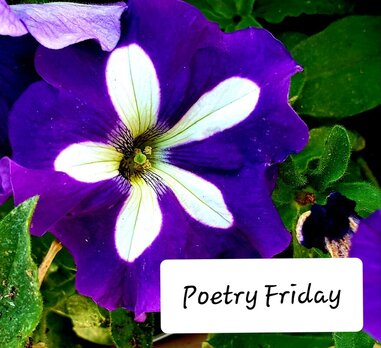 Margaret at Reflections on the Teche is hosting us today. She has added a beautiful and poignant line to the 2022 Progressive Poem today. Today I am thrilled to have an interview with Helen Frost on her new book, Wait-And See with the phenomenal photographer Rick Lieder. I was fortunate to work with Helen at a Highlights Foundation "Novel in Verse" retreat in 2013. She's a most excellent teacher and mentor. 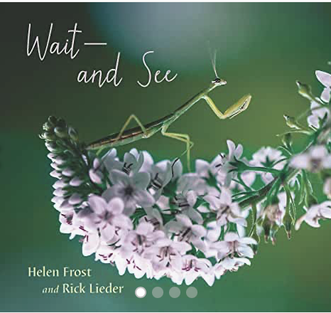 JRM: This is the sixth book in which you have collaborated with Rick Lieder. Could you tell my blog readers a bit about the process: How did this collaboration begin? Do you work together from the start? Which comes first, the photos or the poetry? HF: It began in 2006, when Rick Lieder’s wife, Kathe Koja, and I were doing a book event together, and Kathe said she thought I’d love her husband’s insect photography. She was right—the beautiful photographs made me look more closely at the world right outside my back door, and I started seeing more insects, and paying more attention to them. I wrote a poem about seeing and caring for the insect world, and Rick and I put the poem and images together in a book we started sending around to editors. It was a few years before Sarah Ketchersid, at Candlewick, loved the book as much as we did, and, in 2012, it was published to great reviews and soon found many enthusiastic readers. In the ten years since then, we have collaborated, together with Sarah and others at Candlewick, to produce five more books, with another under contract for 2024. Neither poetry or photos comes first—we usually start talking about a new book when one of us has an idea, and then there is about a year of back-and-forth as we refine the idea until it is ready to send as a proposal to Sarah. The proposal is usually a poem and accompanied by about 50 possible images. After it is accepted, lots more work goes into creating the finished book. I keep working on the text, and Rick continues to take and select more images as the book comes into being. JRM: How many drafts were there for Wait and See? What type of research did you do for the book? And did you write the back-matter as well? HF: It’s impossible to say how many drafts there are, because I save my work hour by hour as I go. But I think I could estimate that there are between 20 and 50 versions. I sometimes change a line in the poem to “match” an image I love, and Rick sometimes finds a better image for a line we don’t want to let go. Yes, I do a lot of research as I write the poems, and continue to learn more as I write the backmatter. I begin with books and online research, and correspond with experts as needed. JRM: What was the most surprising thing you learned about the praying mantis? HF: I was surprised to learn how many nymphs emerge from one ootheca (egg case). There can be as many as 400—which makes you think about all the dangers they face, and how amazing it is when one survives to adulthood, and you see it looking at you! JRM: Not only does the book teach about praying mantis, How did you arrive at the title, Wait and See? It says so much more than the arrival of praying mantises and I can see how teachers would use this in the classroom. HF: Yes, Wait—and See (the dash in the title suggests the waiting) does emphasize an important aspect of the book. Praying mantises are hard to find, and the book can help children learn where and how to look for them, but even more, it shows how important patience is in many ways. I’d love to think that teachers might read this book to children and then go outside and encourage the children to quietly look around and come back in to share what they’ve seen. It would be unlikely to be a praying mantis (though wouldn’t that be great?) but they’ll definitely see something. And maybe the book will help them learn the art and value of being still and attentive in many situations. If you look at each of our books, there is a “big idea” like this behind each of them. They are often given as gifts (to children and adults) for special life events: birth of a first child or a new sibling (Hello, I’m Here! and Wake Up), engagement or marriage (Among a Thousand Fireflies), milestones such as first day of school or graduation (Step Gently Out and Sweep Up the Sun). And I know that Sweep Up the Sun has brought comfort to people grieving the loss of a loved one. JRM: You have written several novels in verse. I noticed that you call them “novels in poems”. How did you arrive with this term (which I rather like)? HF: I love poetry, and I love using different elements of poetry in my picture books and novels; the term “novels-in-poems” (though I’m not adamant about it) is a way of calling attention to that. JRM: What are your current projects? HF: Rick and I are collaborating on a new book, probably to come out in 2024, tentatively titled The Mighty Pollinators, about pollen and pollinators. The “big idea” behind this book is that small things like pollen and pollinators are essential. As we were discussing this, Rick pointed out, “Our readers are small, too, and they are important.” JRM: Thank you, Helen, for giving me and other readers insight on this fabulous insect. I am looking forward to your next project as pollinators are one of my favorite studies. Giveaway TimeAnne Irza-Leggat, Educational Marketing Manager at Candlewick, has generously offered a copy of last week's book, Out of This World by Sally Walker and this week's book Wait-and See by Helen Frost. Leave a comment by April 27 on either blog post to be eligible to win. Winners will be announced next week. Speaking of Winners...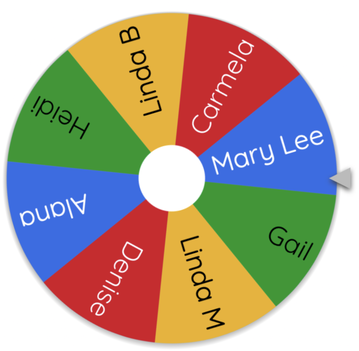 Mary Lee Hahn, you have won the 3d drawing and optical illusions: how to draw optical illusions and 3d art step by step Guide for Kids, Teens and Students. New edition and a set of Staedtler Mars Lumograph Art Drawing Pencils, 12 Pack Graphite Pencils in Metal Case . Congratulations. Tabatha will be sending that out soon. 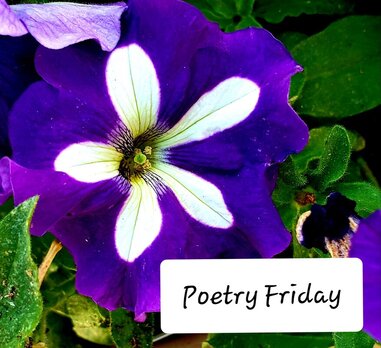 Matt at Radio, Rhythm & Rhyme has hosting duties this Poetry Friday. Matt has a terrific interview with Leslie Bulion. Here I have an interview with Sally Walker. Thanks to Mary Lee, I got in touch with Anne Irza-Leggat at Candlewick Press. She connected me with two poets for this month that have new books coming out in April. In the fall, I will be interviewing two more poets when their books arrive in the world.  From Sally Walker's Website From Sally Walker's Website Meet Sally Walker. This picture tell me that she and I could be great friends as I love a good hug with a tree. from early readers to nature books STEM books, history and picture books, Sally has written so many. Earth Verse was her first book written in haiku. Her latest, Out of This World: Star-Studded Haiku, is as she says a "language spaceship" . Through haiku, readers will travel the universe. There's great back matter at the end of the book. Sally was gracious to answer questions I had for her. I loved learning about the diamonds that a certain planet has (read the interview to find out). 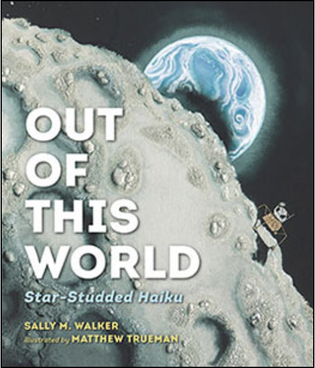 JRM: How did you get the idea for Out of This World: Star-Studded Haiku? What was your process for writing this book? SW: The idea began with a haiku that I wrote about Saturn: Rings of rock and dust/circle around Saturn’s waist/cosmic Hula-Hoops. It made me smile, as I remembered summer days spent playing with a Hula-Hoop. It became part of a manuscript with the working title Sci-ku. As I have done in many of my books, I wanted to create a book that would as a bridge to connect science with literature—one that combined facts and language play. Sci-ku’shaiku ranged from geology, to space, to physics, and to biology. I submitted the manuscript to Hilary Van Dusen, my editor at Candlewick. She liked the idea, but felt that the book would be more effective if all of the haiku immersed the reader in one particular scientific field. She was absolutely correct! I narrowed the focus to geology, my number one science love. The manuscript became Earth Verse: Haiku from the Ground Up. The haiku about Saturn ended up on the cutting room floor. Sadly, because I really liked that one. After completing Earth Verse, Hilary asked if I was working on anything else. I wasn’t, but suddenly the “cosmic Hula-Hoops” haiku popped back into my mind. My email reply to her suggested that I do a companion volume to Earth Verse that could be titled Out of This World: Star-studded Haiku. Of course I included the haiku about Saturn among those that I submitted in my formal proposal! Part of my process for writing Out of This World was paying attention to the stars, planets, and the moon as they appear to move across the sky as Earth rotates. Early morning, just before dawn, is my favorite time to be outside. Even on the coldest days, I go for a walk and look at the moon and the stars. Another part of my process was to look at the stellar—ha, ha, that pun was too good to resist—photos on the National Aeronautics and Space Administration’s (NASA) website, www.nasa.gov. It’s an awesome website where one can spend hours immersed in all kinds of space-related information. The photos are beyond belief!! JRM: I think one of the best parts about writing is doing research for a topic. What kind of research did you do for Out of This World? SW: Research is, hands down, my favorite part of being an author! An important part of writing this book, which later morphed into research, came from re-living experiences from my childhood. For example, I remember sitting in the backyard with my father on summer nights. He would point out different constellations—Orion and the Big Dipper are two vivid memories—and tell me stories about how they got their name. My family always watched lunar and solar eclipses. We always used the pinhole in cardboard way to view a solar eclipse safely. One Christmas, when I was about 10 years old, my cousin received a telescope as a gift. He invited us to his house one night so we could see Saturn’s rings. That blew me away! Maybe that’s how Galileo felt when he first saw them. In July 1969, half the people in our neighborhood crowded around the television in my family’s livingroom and watched the Eagle land on the moon. We all held our breath until it touched down and then cheered!! Reality TV at its absolute best!!! I researched scientific papers, books, old newspapers, and NASA’s website about all of these topics for additional information, as well as important updates, to material that I remembered from childhood. Interestingly, research that I’d done for other books gave me a lot of information for Out of This World. My research adventures for Boundaries, my book about the Mason-Dixon line, led to planetarium visits and lots of stargazing. Charles Mason and Jeremiah Dixon drew their famous line of latitude guided by the position of stars. My husband, a volcanologist, was happy to talk with me about the Martian volcano Olympus Mons, the largest volcano in our solar system. In college, when I majored in geology, I learned that scientists theorize that an asteroid strike 65 million years ago likely led to the extinction of dinosaurs on Earth. It seemed natural for me to write a haiku about that. JRM: What was the most surprising discovery you had in writing this book? SW: Good question! One discovery that I knew absolutely NOTHING about was that it rains diamonds on the planet Uranus. That planet, one of our solar system’s four planets that have no solid land surface, has a slushy plasma ocean that surrounds the planet’s solid core. The pressure within the ocean forces carbon atoms to crystallize as diamonds. Because the diamonds are heavier than the surrounding “slush,” they rain downward, toward the core. This discovery also led to a funny research story. When Matthew Trueman was creating the illustration for the haiku diamonds rain, unseen/in a slushy plasma sea/sunken treasure trove, he asked what color the sea was likely to be. I had NO idea. So, I did some research. I emailed Dr. Dirk Gericke and asked him. He is a professor at the Centre for Fusion, Space & Astrophysics, in the Department of Physics, at the University of Warwick, in the United Kingdom. Dr. Gericke has written several papers on Uranus’s plasma sea. He helped me tweak the haiku so it was accurate, but he also consulted with his colleagues about the color of the plasma ocean. While no one can actually see it, their consensus (based on the chemical composition) is that the sea is bluish. I passed this information along to Matthew! JRM: What led you to write this book in haiku? How do you decide if you want to write in prose or haiku? SW: It was always intended to be a combination of haiku and nonfiction prose. My favorite haiku are those that not only make me think or feel about something, but also make me want to discover something new about the “moment” that I encountered while reading a particular haiku. I hope that the haiku in Out of This World will make readers think and ask questions. The narrative section of the book, hopefully, provides answers to some of those questions. Haiku is pretty much the only kind of poetry that I write. But I did not always enjoy it. I remember being taught about haiku in fourth grade. The teacher explained what it was: a short poem that did not rhyme, had only seventeen syllables, and revealed a profound, seasonal moment in nature. We didn’t talk about Japanese culture at all. Nor did we discuss how “less” can actually be “more.” She just read us a few haiku written by Basho and Issa. Sadly, I was too young to appreciate them—at least the ones she read to us. They made me feel “itchy” because I didn’t understand what they were about. When she asked us to write haiku, I felt like I was being asked to write something so profound that it was incomprehensible. Forcing the incomprehensible into a seventeen-syllable, non-rhyming poem made the assignment essentially impossible for me. Now, as an adult, I read a haiku like Basho’s The Old Pond (An old silent pond/a frog jumps into the pond--/Splash! Silence again.) and marvel at it. But the nine-year-old me wouldn’t have understood and appreciated all it encompasses. I would not have savored that exquisite last moment. I would have splashed into the pond and caught the frog. Today’s young readers meet haiku through the mastery of poets such as Paul Janeczko, Janet Wong, and J. Patrick Lewis. Children easily relate to their poems. They meet the reader in a place or moment that she or he can understand. A park bench, a curbside puddle, a beloved pet. That is incredibly powerful and freeing. Modern haiku poets often step outside the traditional guidelines of including a seasonal reference. And they frequently inject humor. Many of the haiku in Earth Verse and Out of This World explore moments in nature, but they are moments that exist for eons. I remember one of my geology professors telling us that in the timeline of life on Earth, humans have existed in the length of time that it takes to light a match and immediately blow it out. The formation of stars, land surfaces being eroded by glaciers and wind, an asteroid that wipes out millions of years of dinosaur existence are natural, cosmic “moments.” They exist on a timeline, the length of which we can scarcely comprehend. Why not write haiku about them? Although some poets write haiku that don’t strictly adhere to the seventeen-syllable format, I choose to do so. I like the challenge of seeking the perfect combination of words to convey an idea or impression in exactly seventeen syllables. It’s a game with language that lets me play with words, something I love to do. It requires lots and lots and lots of mental revision to get the syllable count for each line correct. That’s cool too, because many of the haiku that I write finally reach their “Eureka!” word-choice completion while I am outside walking and appreciating nature! JRM: What are your upcoming projects? SW: My next book is UNDERGROUND FIRE: HOPE, SACRIFICE, AND COURAGE IN THE CHERRY MINE DISASTER. The 1909 Cherry Mine fire is one of the worst coal mine disasters in United States’ history. My home is only 50 miles from Cherry, Illinois, and the story is one that I have wanted to bring to young readers for some years. It’s especially timely, given that it’s a story of immigrants and fossil fuel, both of which figure prominently in the news today. The publication date is October 2022. I do have another haiku book in the pipeline, scheduled for publication in Spring 2023. At the moment the title is TREES: HAIKU FROM ROOTS TO LEAVES. It's a bit early to share much more about it, but I can say that the illustrations are wonderful! Both books are with Candlewick Press. BONUS I: In another email, Sally and I shared an exchange about writing haiku for adults as well as the haiku structure. She shared this haiku Language meanders, words channeled into patterns. Poetic rivers BONUS II: Regarding haiku versus senryu Sally shared this little fact, I enjoy senryu a lot. In fact, I had to avoid producing them when I wrote Earth Verse and Out of This World. Thank you so much, Sally!
|
AuthorAll photos and poems in these blog posts are copyrighted to Jone Rush MacCulloch 2006- Present. Please do not copy, reprint or reproduce without written permission from me. Categories
All
Archives
July 2024
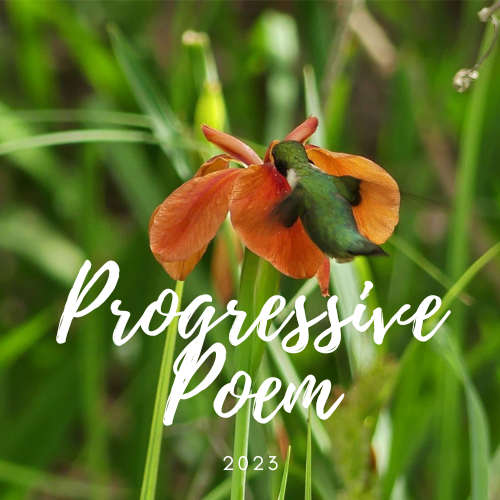
2023 Progressive Poem
April 1 Mary Lee Hahn, Another Year of Reading April 2 Heidi Mordhorst, My Juicy Little Universe April 3 Tabatha, The Opposite of Indifference April 4 Buffy Silverman April 5 Rose Cappelli, Imagine the Possibilities April 6 Donna Smith, Mainely Write April 7 Margaret Simon, Reflections on the Teche April 8 Leigh Anne, A Day in the Life April 9 Linda Mitchell, A Word Edgewise April 10 Denise Krebs, Dare to Care April 11 Emma Roller, Penguins and Poems April 12 Dave Roller, Leap Of Dave April 13 Irene Latham Live You Poem April 14 Janice Scully, Salt City Verse April 15 Jone Rush MacCulloch April 16 Linda Baie, TeacherDance April 17 Carol Varsalona, Beyond Literacy Link April 18 Marcie Atkins April 19 Carol Labuzzetta at The Apples in My Orchard April 20 Cathy Hutter, Poeturescapes April 21 Sarah Grace Tuttle, Sarah Grace Tuttle’s Blog, April 22 Marilyn Garcia April 23 Catherine, Reading to the Core April 24 Janet Fagal, hosted by Tabatha, The Opposite of Indifference April 25 Ruth, There is no Such Thing as a God-Forsaken Town April 26 Patricia J. Franz, Reverie April 27 Theresa Gaughan, Theresa’s Teaching Tidbits April 28 Karin Fisher-Golton, Still in Awe Blog April 29 Karen Eastlund, Karen’s Got a Blog April 30 Michelle Kogan Illustration, Painting, and Writing |
